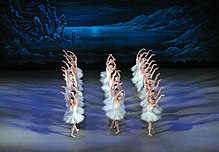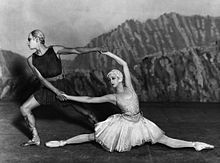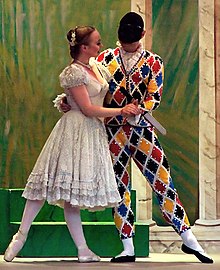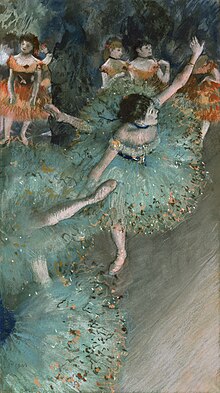Ballet
The ballet, academic dance, classical dance or balé It is a type of dance and also the name of the corresponding technique. Depending on the times, countries or currents and the show, this artistic expression can include: dance, mime, and theater (orchestra and choir), people and machinery.
Classical ballet or classical dance is a form of dance whose movements are based on total and absolute control of the body, it is recommended to start from an early age due to its degree of difficulty. Unlike other dances, in the ballet each step is coded. The hands, arms, trunk, head, feet, knees, the whole body invariably participate in a simultaneous conjunction of muscular and mental dynamics that must be expressed in total harmony of movements.
The term ballet is also used to designate a piece of music composed, on purpose, to be interpreted through dance. The ballet is one of the performing arts.
Etymology
The word ballet, taken from the Latin ballo, ballare, "to dance", in turn taken from the Greek βαλλίζω (< i>ballizo), 'dance', 'jump'.
The term ballet was first used in 1582 by the French composer Balthasar de Beaujouelx (also known as Balthazar de Beaujoyeulx) in the Ballet comique de la reine.
History of dance
The history of dance studies the evolution of dance through time. Since prehistory, human beings have had the need to communicate bodily, with movements that express feelings and moods. These first rhythmic movements also served to ritualize important events (births, deaths, weddings). In principle, the dance had a ritual component and was celebrated in ceremonies of fertility, hunting or war, or of a diverse religious nature, where one's own breathing and heartbeat served to give the dance a first cadence.
The ballet, as we know it today, arose in Renaissance Italy (1400-1600). It was in France during the reign of Louis XIV, nicknamed the Sun King, that the need for professionalization arose and in 1661 the first dance school was created: the Académie Royale de la Dance. In 1700, R. A. Feuillet published Choréographie ou art de noter la danse where for the first time all the coded steps were reproduced and a first attempt at transliteration or notation of the figures was founded. In 1725, Jean-Philippe Rameau with his Traité Maître à danser perfected all the technique proposed up to then.
Balthazar de Beaujoyeulx was not only the first to use the word ballet, but also defined it as 'a geometric mixture of people who dance together, accompanied by various musical instruments '. However, Bastiano di Rossi managed to give it a better definition, saying that the ballet is 'a pantomime with music and dance'.
At the birth of the romantic ballet, the reforms carried out by G. Magri with his Trattato teorico-practico di ballo (in 1779), which provided a intact repertoire of figures and by J. G. Noverre with his treatise Lettre sur le ballets et les arts d'imitation where he gives life to the ballet d'action (the ballet pantomime). In 1713 the second Académie Royale was created, which today is known as the Paris Opera.
All this reform was experienced and put into practice by F. W. Hilferding in 1735 upon returning to his hometown Vienna. He was appointed ballet master and in 1740 he undertook the task of introducing Realism into the ballet itself.
The popularity of ballet waned after 1830, but it continued to be practiced in countries such as Denmark, Italy, and Russia. The arrival of the Russian ballets, introduced to Europe by Sergei Diaghilev, led to increased interest during World War I.
Styles
Stylistic variations and subgenres have evolved over time. The first classical variations are mainly associated with geographical origin. Examples of this are the Russian ballet, the French ballet and the Italian ballet. Later variations, such as contemporary ballet and neoclassical ballet, incorporate both classical ballet and non-traditional techniques and movements. Perhaps the best-known and best-performed style of ballet is the late romantic ballet (or ballet blanc).
Classical ballet
Classical ballet is based on the technique and vocabulary of traditional ballet. Different styles have emerged in different countries, such as French ballet, the Italian ballet, the English ballet and the Russian ballet. Several of the classical ballet styles are associated with specific training methods, often named after their creators (see below). The Royal Academy of Dance Method is a ballet technique and training system that was founded by a diverse group of ballet dancers. They fused their respective dance methods (Italian, French, Danish and Russian) to create a new style of ballet that is unique to the organization and is recognized internationally as the English style of ballet i>. Some examples of classical ballet productions are: Swan Lake, Sleeping Beauty and The Nutcracker.
Romantic Ballet
The romantic ballet was an artistic movement of classical ballet and several productions remain today in the classical repertoire. The Romantic era was marked by the rise of la pointe, the dominance of ballerinas, and longer, flowing tutus that attempt to exemplify softness and a delicate aura. This movement occurred in the early to mid-century XIX (the romantic age) and featured themes that emphasized intense emotion as a source of aesthetic experience. The plots of many romantic ballets revolved around spiritual women (sylphs, wilis, and ghosts) who enslaved the hearts and senses of mortal men. The 1827 ballet La Sylphide is considered the first, and the 1870 ballet Coppélia is considered the last. Famous ballet dancers of the Romantic era include Marie Taglioni, Fanny Elssler and Jules Perrot. Jules Perrot is also known for his choreography, especially that of Giselle , often regarded as the most celebrated romantic ballet .
Neoclassical ballet
The neoclassical ballet is usually abstract, without a clear plot, costumes or scenery. The choice of music can be diverse and will often include neoclassical music as well (eg Stravinsky, Roussel). Tim Scholl, author of From Petipa to Balanchine, considers George Balanchine's 1928 Apollo (ballet)|Apollo to be the first neoclassical ballet. Apollo represented a return to form in response to the abstract ballets of Sergei Diaghilev. Balanchine worked with modern dance choreographer Martha Graham, and brought modern dancers to his company such as Paul Taylor, who in 1959 performed in Balanchine's Episodes .
Although Balanchine is widely considered the face of neoclassical ballet, there were others who made significant contributions. Frederick Ashton's work Symphonic Variations by Frederick Ashton. (1946) is a fundamental work for the choreographer. Based on the score of the same title by César Franck, it is an interpretation of the score in the key of pure dance.
Another form, modern ballet, also emerged as an offshoot of neoclassicism. Innovators of this form include Glen Tetley, Robert Joffrey, and Gerald Arpino. Although it is difficult to separate modern ballet from neoclassicism, the work of these choreographers favored a greater athleticism that moved away from the delicacy of ballet. The physique was bolder and the atmosphere, theme and music more intense. An example of this would be Joffrey's Astarte (1967), which featured a rock score and sexual undertones in the choreography.
Contemporary Ballet
This style of ballet is usually performed barefoot. Contemporary ballets may include mime and acting, and are often set to music (usually orchestral, but occasionally vocal). It can be difficult to differentiate this form from neoclassical or modern ballet. Contemporary ballet is also close to contemporary dance because many concepts of contemporary ballet stem from the ideas and innovations of 20th century modern dance XX, such as floor work and leg twists. The main difference is that ballet technique is essential to perform a contemporary ballet.
George Balanchine is considered to be the pioneer of contemporary ballet. Another early contemporary ballet choreographer, Twyla Tharp, choreographed Push Comes To Shove for the American Ballet Theater in 1976, and in 1986 she created In The Upper Room for her own company. Both pieces were considered innovative for their fusion of distinctly modern movements with the use of pointe shoes and classically trained dancers.
Today, there are many contemporary ballet companies and choreographers. Among them are Alonzo King and his company LINES Ballet; Matthew Bourne and his company New Adventures; Complexions Contemporary Ballet; Nacho Duato and his National Dance Company; William Forsythe and The Forsythe Company; and Jiří Kylián from the Nederlands Dans Theater. Traditionally 'classical' companies, such as the Mariinsky (Kirov) ballet and the Paris Opera ballet, also regularly perform contemporary works.
The term ballet has evolved to include all forms associated with it. Now someone training as a ballet dancer is expected to perform neoclassical, modern and contemporary works. A ballet dancer is expected to be able to be stately and regal in classical work, free and lyrical in neoclassical work, and brash, rough, or pedestrian in modern and contemporary work. In addition, there are several modern varieties of dance that fuse classical ballet technique with contemporary dance, such as Hiplet, which requires dancers to have practice in non-Western dance styles.
Teaching methods
Currently all the methods are sources of mutual inspiration, but it is worth knowing the origin of each one of them. There are different methods, a basic legacy of four.
In 1661, the first Académie Royale de danse officially considered professional was created in France. Known as Classical Dance. Through its constituted terminology, it spread as a reference throughout the world. Characterized by extreme precision in execution and the refined elegance of the movement. It was not until 1920 that the contributions of the Italian school and its numerous Russian artists were integrated, developing from the mid-century XX< /span>, a move that will accentuate the extreme points of the jumps and the spread.
Danish School, heir to the Italian tradition, leads to develop a particular style where the virtuosity of the dancers is underlined by the work of the speed of the feet. The batteries, the accent, the bearing, on the legwork, the vivacity in the linking steps and in the jump. The Bournonville style is characterized by the continuity of the Enchaînements, lightness and rhythmic precision.
In 1820, the Italian School of Dance was founded by Enrico Cecchetti (1850-1928). It has a great tradition of pantomime, an implementation of the French style contributed by Carlo Blasis. Its main characteristics are the continuity of the flow of movement in displacements and the center of gravity.
In Russia, Agrippina Vaganova (1879-1951) developed the Vaganova Method. Vaganova will create a pedagogical system that will contribute to the formation of the Russian School. This method moves away from the graceful French gestures, giving way to the gravitation of the Cecchetti method, accentuating the weight, the poise to the ground, the force of the impulse and developing extreme muscular elasticity. It is the basis of ballet teaching at the Vaganova Ballet Academy in St. Petersburg.
The American school is influenced by Italian (provided by Tudor) and Russian (provided by George Balanchine and other choreographers and dancers from Sergei Diaghilev's Ballets Russes). This school is nourished by the emigration of teachers after the Russian Revolution of 1917. The notorious Soviet expansion of the period will contribute to the birth of other new schools in the world, such as the Cuban school based on the Vaganova method and promoted by Alicia Alonso.
The ballet has a fairly complex technique. The main element is placement. Positioning refers to keeping the shoulders and hips in the same plane and parallel to each other in relation to the floor. This principle allows the dancer to increase clarity and precision in handling directions as the legs move in different directions. The torso in ballet functions as a unit and has generally been perceived as immobile, which is not true. Actually, the torso moves subtly in relation to the breath phrasing of the moves and combinations. Torso placement provides stability during movement of the working leg as the supporting leg is extended upward. The kinesthetic sensation of a dancer's torso and stance become more important when integrated with changes of direction at the bar and center.
In 1920, five of the most important figures in the world of Dance such as Adeline Gene, Tamara Karsávina, Lucia Cormani, Edouard Espinosa and Phillis Bedells, who in turn represented the main teaching methods of the moment, exactly 31 December 1920, they decided to create an Association of Dance Teachers with the sole objective of "improving the standard of teaching Classical ballet". Following the model of L'Academie Royal de Danse, founded in Paris by Louis XIV, with the aim of correcting the multiple errors that occurred in dance at that time, the Royal Academy of Dance has been acting in two ways: one the aforementioned and the other as caretaker of the fundamental technique of the art of dance. The Royal Academy of Dance provides the necessary material with the support of books, music and videos so that classical dance students can learn the necessary technique and there are Royal teachers in various countries such as Ireland, Spain Cocia, Wales, Andorra, Austria, Belgium, Denmark, France, the United States, Canada, Mexico, etc.
The tips
Potes are special slippers, which dancers acquire when they have the required strength in the foot and calf muscles. At the beginning of this process, the dancers suffer from intense pain in their fingers and joints, but over the years they gain greater strength that makes their feet suffer less and less. The first ballerina to stand on tiptoe was Marie Taglioni, in the ballet La sylph , whose choreography was created by her father.
The use of ballet points in students is programmed towards the end of the first year of ballet (Vaganova School), when the muscles are already prepared. [citation needed] The exercises at this stage are very basic, limiting yourself to rising on your toes on both feet and always with the help of the bar. Then they begin to do more complex steps such as pirouettes and jumps on the tips.
There are different types of pointe shoes, from different parts of the world. Russian and American are the main ones. Each shoe adapts to the different needs and capacities of the dancers. For example, the arch, the strength of the instep...
When buying points, the dancer has to take into account the type of foot she has: Egyptian, Greek or square in order to find the ideal fit for her feet.
General information
The ballet exists as an autonomous piece, as part of the scenes of an opera or a play as entertainment. The French courtly ballet is contemporary with the first rehearsals of the dramatic monody of Florence (the intermediate ones, from the end of the XVI century).). The ballet-operas and ballet-comedies of Lully and Molière were born from the performances of the court ballets.
The interspersed ballet, inserted into an opera, is specific to French lyric art, as reflected in the performances of lyric tragedies by Lully and Rameau. Noverre's reform (action ballet) and even those of Gluck.
The modern ballet comprises a succession of episodes that are continuously linked. Wagnerian conceptions no longer contemplate the practice of interspersed ballet.
In the XX century, the ballet is the object of all kinds of renovations and experiments. The premiere of The Rite of Spring (1913) by Igor Stravinsky with a choreography by Vaslav Nijinsky caused one of the biggest scandals in the history of music and dance.
Modern ballet, however, maintains a more classical language (Maurice Ravel La Valse, 1920), which with its stylization takes up the conceptions of ballet Classical : Richard Strauss (dance suite from The bourgeois gentleman) and Igor Stravinsky, Apollo).
It must be remembered that the ballet is the base of the rest of the dances.
Gallery
Contenido relacionado
James Randy
Silver braiding
Civilization














